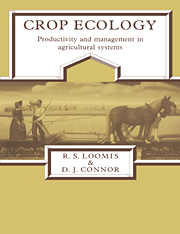Book contents
- Frontmatter
- Contents
- Preface
- Part I Farming systems and their biological components
- Part II Physical and chemical environments
- Part III Production processes
- Part IV Resource management
- 12 Soil management and sustainability
- 13 Strategies and tactics for rainfed agriculture
- 14 Water management in irrigated agriculture
- 15 Energy and labor
- 16 Analysis of wheat–sheep farming in southern Australia
- 17 Mixed farming in the North American Corn Belt
- 18 Towards an uncertain future
- References
- Species list
- Conversions and constants useful in crop ecology
- Index
15 - Energy and labor
from Part IV - Resource management
Published online by Cambridge University Press: 05 June 2012
- Frontmatter
- Contents
- Preface
- Part I Farming systems and their biological components
- Part II Physical and chemical environments
- Part III Production processes
- Part IV Resource management
- 12 Soil management and sustainability
- 13 Strategies and tactics for rainfed agriculture
- 14 Water management in irrigated agriculture
- 15 Energy and labor
- 16 Analysis of wheat–sheep farming in southern Australia
- 17 Mixed farming in the North American Corn Belt
- 18 Towards an uncertain future
- References
- Species list
- Conversions and constants useful in crop ecology
- Index
Summary
INTRODUCTION
All human activity requires energy. The inescapable minimum is the dietary energy to maintain the population. In earlier times, if one hunter-gatherer could be sure to collect around 33 MJ each day of the year for the family unit (man, woman and two children), then survival of the population was possible. In practice, more organic materials, some with a dietary value, were needed for clothing and shelter. In some cases, there were additional, compulsory contributions to support chiefs, priests, and warriors.
Agriculture provided a way to secure that supply of food and other biological raw materials with less environmental hazard and less competition from other organisms. By its success in raising and stabilizing yields, agriculture has supported an increasing population and released an increasing proportion of it from the persistent chore of food production. With a productive agriculture, societies are more able to participate in the leisure, recreational, cultural, and scientific activities that improve wellbeing. Agricultural productivity has increased per worker and per hectare because the declining number who remain laboring in the field are supported by machines and because inputs of information, improved cultivars, fertilizer, water, and agrochemicals amplify the performance of crop systems.
The development and maintenance of industrialized cultures is based upon the substitution of energy for labor in the non-optional activity of food provision. At the same time, everyone in such cultures, including those who work in agriculture, has developed even greater energy demands for other activities.
- Type
- Chapter
- Information
- Crop EcologyProductivity and Management in Agricultural Systems, pp. 400 - 427Publisher: Cambridge University PressPrint publication year: 1992



